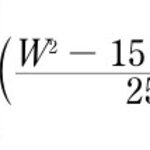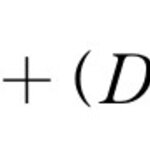Mathematics

The first fax machine had no value. It couldn't send a fax to anyone. It was, from a value perspective, useless.
The second fax machine added value to the first because it now had something which could receive faxes. The third added value to the first two and received value from them in the network as well. As each fax machine came into existence, the value it added was nonlinear. The more fax machines that existed, the more value each of them had.
Many things in life are like that. They don't necessarily follow a Bell curve, they follow something else, a power law distribution,…

The American Institute of Mathematics (AIM), one of the leading math institutes in the U.S., announced today that after four years of intensive collaboration, 18 leading mathematicians and computer scientists from the U.S. and Europe have successfully mapped E8, one of the largest and most complicated structures in mathematics. Partners on this project included MIT, Cornell University, University of Michigan, University of Utah and University of Maryland.
The E8 root system consists of 240 vectors in an eight-dimensional space. See what is E8? Those vectors are the vertices (corners) of…

In theory, if you could define all the factors that go into making a decision and could define exactly how important is each of these factors, and could define how these factors interact, you could make an equation that precisely solves any decision. Of course, to be perfect, this equation would have to be tweaked and amended to include the variables that are relevant to each person making the decision, and the framework of the equation would have to reflect their personal value systems, etc.
What a pain in the neck!
It's much easier (and funnier!) just to wink at the problem and shoot to…

I have been studying differential equations, and developed a theorem about linear second order equations. I have not been able to find it anywhere else on the web or in my textbooks, and so I thought I would post it up here. Click "read more" to see the theorem.
If y is the solution of a linear second order differential equation, y'' + py' + qy = g, and assuming p, q, and g are functions of an independent variable, and if q =1/2(p' + 1/2*p^2) then there exists an integrating factor μ = exp(int(p/2)), such that (μy)'' = L[y].
Can anybody give me some feedback? Has anone…

In this equation, it's probably pretty obvious what you should do. But is your life ruled by should? Do you gimp through your week yessir-ing and nomam-ing and cowtowing to avoid punishment? Okay, so do most of us—but here's your chance to break the mold and stike a blow for the proletariat (viva la revolucion...). And at least if you get caught blowing off the rest of the day in favor of a four-hour, three-martini, expense account lunch at the pub, you can blame the numbers.
Should I order a sandwich at my desk or head to the bar on the corner for a blowout lunch?
P= Level of…

Usually when you turn on the tube, you can be fairly certain what you are going to see—you know a show’s genre, actors, and reputation and even supposedly unscripted reality television rarely bucks expectations. Enter the Academy Awards. Some years it’s great and other years David Letterman hosts. That’s part of the fun and one reason an average of nearly 45 million viewers tune in every year—we crave the potential to catch Madonna yelling at the sound tech after her microphone failed to emerge from the floor; we love the behind-the-scenes stories of…

When you turn on the Oscars, what are you really watching? Most people admit it's a good excuse for a fashion show. And it seems an obvious choice between Keira Knightley’s elegant, wine-colored Vera Wang and Gwyneth’s 2003 gothic horror show. But then why, if it’s that obvious, do stars continue to mistake the Oscars for that other dress-up day on the 31st of October? With a cadre of stylists, trainers and designers, and without needing to fit the dress inside a small pocketbook, wouldn’t you think they could get it right every time?
Now they can.
Will Her Oscar Dress Be A Hit?…

A mathematical model of disease cycles developed at the University of Michigan shows promise for predicting cholera outbreaks.
Speaking in a symposium titled "New Vistas in the Mathematics of Ecology and Evolution" at the annual meeting of the American Association for the Advancement of Science in San Francisco, theoretical ecologist Mercedes Pascual will discuss how models that she and coworkers have developed can aid short-term forecasting of infectious diseases, such as cholera, and inform decisions about vaccination and other disease-prevention strategies.
In research done over the past…

At last, neuroscience is having an impact on computer science and artificial intelligence (AI). For the first time, scientists in Tomaso Poggio’s laboratory at the McGovern Institute for Brain Research at MIT applied a computational model of how the brain processes visual information to a complex, real world task: recognizing the objects in a busy street scene. The researchers were pleasantly surprised at the power of this new approach.
“People have been talking about computers imitating the brain for a long time,” said Poggio, who is also the Eugene McDermott Professor in the Department of…

Suzuki roshi, in his wonderful Zen mind, beginner's mind, talks about the mental approach necessary for the study of Zen. It's an open, naïve attitude, without preconceptions and without habits which limit thought into certain patterns. I think it's the same as that the scientist should employ.
Chess players understand the game and its moves and possibilities so well that they can quickly size up a situation. You may have seen masters playing a game by calling out moves to one another, without the presence of a board or pieces. It's not all about memory and concentration, but also the fact…